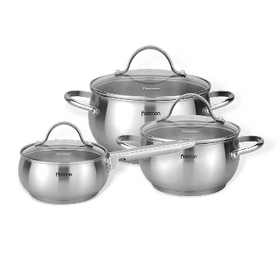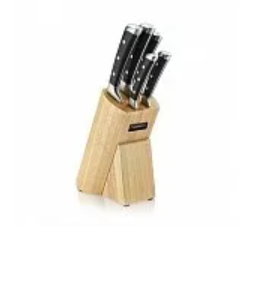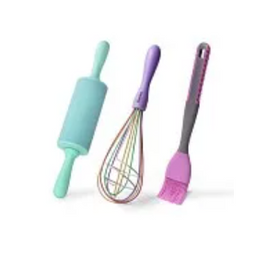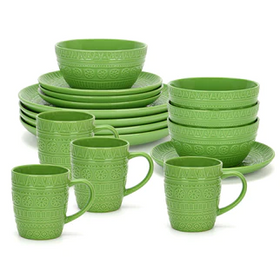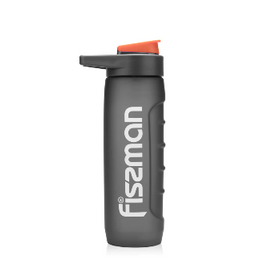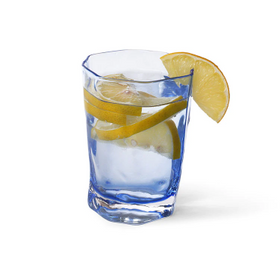The Advantages Of A Stone Frying Pan
Despite the name, the modern stone frying pan is made of metal. It has only a non-stick coating made of stone. But this gives several characteristic advantages for such cookware such as;
1. Cooking without oil. The surface is smooth and has a lovely texture, allowing you to fry food with little or no oil.
2. Mechanical strength. Suitable for regular and daily use. It does not lose its function.
3. Highly durable. An average life span of 3-5 years. With proper care - even longer.
4. Easy to clean. The container is non-stick and can be easily washed by hand using standard gel products.
5. External aesthetics. The cookware has a spectacular surface with small light speckles.
6. Compatible with various cookers. The modern models are equipped with a thick ferromagnetic insert in the base. It accelerates heating.
7. Safe for your health. The coating does not contain any heavy metals. It has no odor when heated.
How stone-coated cookware differs from the others
When speaking of this kind of cookware, they come in two different categories. They are the marble pan and the granite pan. Marble and granite are used to make the most important part of them - the protective coating. Stone differs from the other types in the following ways
- It gives the ingredients a crispy golden crust faster;
- Brings out more of the flavor and aroma of the food;
- Makes cooked food more tender.
Professional cooks and manufacturers attribute these properties to the mineral origin of the non-stick coating components. The fine stone chips heat up and release heat evenly and do not destroy the minerals and vitamins in the food but rather help them to open up to their full potential.
In addition, the coating:
- Gives the griddle high non-stick properties;
- Free of heavy metals and PFOA;
- It is compatible with wooden, silicone spatulas.
How Stone Griddles Are Made
Today, any stone griddle is, first and foremost, a non-stick frying pan. The metal casing is made from readily available and kitchen-safe raw materials. The most common material is aluminum. The metal is lightweight and easy to handle. Manufacturers complement the case with a heat-resistant handle of bakelite and apply a nonstick layer.
The granite or marble is crushed to a stone flour to create a secure, protective coating. It is applied to the sandblasted aluminum casing and then baked until it is fully bonded. Such a stone-coated non-stick frying pan has 3 to 5 protective layers. These are thick enough to prevent the dish's ingredients from sticking and the pan itself from getting soiled and scratched.
Types Of Frying Pans
According to the way the casing is made:
1. Pressed. A thin-walled aluminum frying pan for which the bowl is extruded from a flat sheet of metal using an industrial press. Light, almost weightless, and very maneuverable. Ideal for preparing quick meals. For fried eggs or scrambled eggs.
2. Forged. A medium-thick and heavy-duty griddle. The base is made of preheated aluminum on special forging machines. This achieves high quality and uniform layer of metal. The universal frying pan.
3. Cast. A heavy aluminum pan with a thick body produced by casting. This is done by melting metal, pouring it into a mold, cooling it down, sanding it, and coating it with a non-stick layer. The container is durable and suitable for long-term cooking, including frying, stewing, and baking.
According To The Type Of Stone Used For The Coating:
1. Marble-coated pan. Protected with fine marble chips. Has a dark-colored body with light speckles. Pleasantly rough surface. Ideal for meat.
2. Granite-coated frying pan. It can be either standard black and grey or color. Modern technology enables the use of granite for colorful frying pans in pink, blue, green, etc.
What To Cook In Stone-Coated Frying Pans
The versatile non-stick layer, based on natural stone, allows the pan to be used for a wide variety of dishes, including
- Egg-based dishes (glazed eggs, omelets);
- Sweet and baked goods (pancakes, cheesecake);
- Meat (steaks, cutlets);
- Fish (whole fish, fillets, steaks)
- Poultry (chicken breasts, berdas, shanks, turkey)
- Potatoes (golden fried, stewed with vegetables and meat)
- Mushrooms (on their own or as part of hot appetizers);
- Cereal dishes (rice, buckwheat, barley, millet, etc.).
It is possible to roast, stew, or bake in it.
How Long Does A Stone-Proof Container Last?
Each product performs its function for 3-5 years without faults. The average life span of a stone bowl is 4 years. However, it depends on the nature of the individual application. The container will serve you for 5-7 years with care and maintenance.
How To Properly Care For The Stone
The care of the griddle is based on the careful treatment of the stone coating. On the one hand, it is a robust natural material. On the other hand, it takes the full brunt of mechanical and thermal stress. Your job is to minimize its effects and prevent chipping and scratches.
- Wash the cabinet with mild household cleansers in the form of a gel. Avoid harsh sponges and abrasive powders. Washing with a machine is only permitted if the packaging bears an appropriate label.
- Turn and stir the ingredients with non-sharp spatulas while cooking. E.g., made of wood or food-grade silicone.
- The coating does not like sudden temperature changes. Heat the pan over low to medium heat.
- Transfer the cooked food to a separate container. Do not put the pan in the refrigerator so as not to expose the body to a temperature shock.
- After washing, wipe it dry so that water droplets do not spoil the non-stick coating. Store in a well-ventilated cupboard.
How To Clean A Stone-Coated Frying Pan
This cookware is not prone to fouling. The non-stick coating protects the ingredients of the food from sticking and the body from getting dark. Even if you don't see it coming, and onions, carrots, or pieces of meat get burnt on the bottom, they won't stick.
Turn off the gas, let the pan cool down, and rinse in warm running water. Take your time to soak the hot pan. Do not try to wipe off burnt bits of food with a hard sponge. If it looks serious, cool the pan and pour lukewarm water over it, possibly with a drop of detergent. Allow to stand, then rinse well.
How To Choose The Best Pan
A frying pan is a purchase that has to be handled responsibly. It will be your culinary companion for the next 4-5 years. The quality of your meals depends on the contents of the cookware you choose. When choosing a container, pay attention to the parameters that are important for any cookware:
- The sturdiness of the body;
- The heat resistance of the handle;
- The convenience of its positioning;
- The comfortable weight of the product;
- The safety of all components.
Check whether the frying pan comes with a lid. If not, find one directly in the shop. Also, check that the pan is suitable for your cooker:
- The base is compatible with the type of hob;
- The pan's diameter matches the cooking surface.
And don't forget to ask about the manufacturer. A responsible brand:
- Has certificates of product compliance with Russian and international standards;
- Guarantees a certain service life of the product;
- In the case of force majeure, will replace the frying pan.
Fissman Products
Pancake frying pans, sauté pans, universal frying pans, deep frying, and braising pans with a stone coating; FISSMAN has them all in its range. For many years, ordinary housewives and professional cooks have respected the brand's kitchen utensils. Today the collection of stone-coated pans of the brand counts more than 50 items. The range is also constantly being extended.
The most popular models include the cast non-stick pans in black and grey and the brightly colored griddle plates. FISSMAN also produces lightweight pressed and forged pans. The brand is characterized by the high quality of its raw materials as well as by its design. The frying pan bodies are made of aluminum, and the handles are heat-resistant bakelite. All products are certified free of heavy metals and PFOA.

